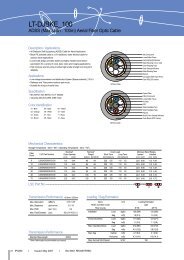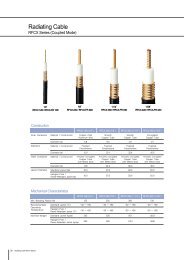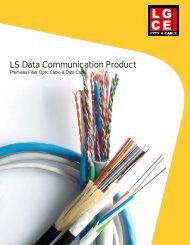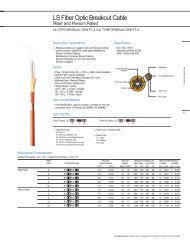Create successful ePaper yourself
Turn your PDF publications into a flip-book with our unique Google optimized e-Paper software.
36<br />
Permissible Short Circuit Currents<br />
6.00 Permissible Short Circuit Currents<br />
The permissible short circuit current of a cable is determined by the maximum permissible conductor<br />
temperature and by the duration of the short circuit current. At high peak currents, the dynamic forces<br />
between the conductors must be taken into account.<br />
The short circuit capacity of the conductor and metallic shield of a cable are related principally to their<br />
heat capacities and are limited by the maximum temperature permitted under short circuit XLPE power<br />
are as follow.<br />
From the two graphs, the short circuit capacity of copper or aluminum conductors (based on a<br />
temperature rise from 90 to 250 ) can be determined.<br />
Logarithmic interpolation between the curves will give estimated values for the various duration.<br />
The curves may be used also to determine the amount of conducting material required to carry a known<br />
short circuit current for a given duration.<br />
Copper Conductor<br />
According to IEC 60949 curves based on formula<br />
where,<br />
Is = Permissible Short Circuit Current (A)<br />
= Factor to allow for heat loss into<br />
the Adjacent Components<br />
S = Cross-Sectional Area of Conductor (mm2 )<br />
t = Duration of Short Circuit (s)<br />
f = Final Temperature (250 )<br />
i = Initial Temperature (90 )<br />
Aluminum Conductor<br />
According to IEC 60949 curves based on formula<br />
where,<br />
Is = Permissible Short Circuit Current (A)<br />
= Factor to allow for heat loss into<br />
the Adjacent Components<br />
S = Cross-Sectional Area of Conductor (mm2)<br />
t = Duration of Short Circuit (s)<br />
f = Final Temperature (250 )<br />
i = Initial Temperature (90 )<br />
Cu<br />
Al









